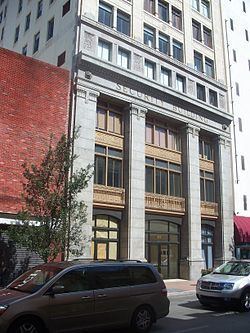NRHP Reference # 88002990 Added to NRHP 4 January 1989 | Built 1927 Opened 1927 | |
 | ||
MPS Downtown Miami Multiple Resource Area Architectural styles Chicago school, Second Empire architecture in Europe Similar Shoreland Arcade, Meyer‑Kiser Building, City National Bank Buil, The Congress Building, Old United States Post Office an | ||
The Security Building (also known as the Capital Lofts Building) is a historic site in Miami, Florida. It is located at 117 Northeast 1st Avenue. On January 4, 1989, it was added to the U.S. National Register of Historic Places. The building has 16 floors with a height of 225 feet (69 m) and was built from 1926 to 1927.
Contents
Design and appearance
The Security Building faces west onto NE 1st Avenue. It is located in mid-block with buildings on either side. Those buildings are considerably shorter than the Security Building. The building maintains a zero-foot setback, and the entry doors open directly onto the sidewalk. There are no landscape features on the property. The building is composed of a main block parallel to the street, and a second block connected perpendicularly that extends to the east.
With only a 50-foot frontage, the architect made a grand statement by creating an almost temple-like base, consisting of the first three stories. Engaged pilasters, that also frame the center bay, articulate the corners creating three distinct bays. Spandrels between the floors are bronze and feature relief ornament. The pilasters carry the entablature, with the name “Security Building” in incised letters. A dentilled molding ornaments the cornice that terminates this division of the building.
The fourth floor begins the transition to the high-rise portion of the building. Stone panels with a similar relief accent the corners and separate the bays. Above the windows of the fourth floor is another projecting element, a stringcourse that is ornamented with a guilloche pattern in relief.
Floors five through thirteen continue the three bays with window arrangements that are grouped in pairs on each of the end bays, and are grouped in three in the center bay, emphasizing the importance of the center bay to the entire composition. The windows are a metal casement type.
The fourteenth and fifteenth floors function as the base for the great mansard roof, which terminates the building. To balance the composition, the two floors are treated as if they were one by the use of a round arch at the fifteenth floor that is carried by the pilasters of the fourteenth floor, so that the two floors are visually united.
A bracketed cornice separates the building from the roof form that is so decidedly different from roof treatments in Miami during this period. A mansard roof is a double-pitched roof with a steep upper slope. The mansard roof was named for architect Francois Mansart (1598–1666). Mansart worked in the seventeenth century and introduced the roof form that extended attic space to provide additional usable area. The mansard roof is a character-defining feature of the Second Empire style that was named after Napoleon III, who took on major building projects in Paris during the eighteenth century. The mansard roof of the Security Building is clad in copper and terminates in a series of antefixae. A series of arches containing windows and serving as dormers penetrate the roof. Bull’s-eye windows are placed between the arched windows. An eight-sided cupola that extends from the center of the roof is fenestrated on each side with a multi-paned arched window. The dome of the cupola also is clad in copper.
The north and south ends of the building are not ornamented. The windows are a metal casement type. The quoining on the corners of the west elevation is repeated in the north and south elevations of the building. The extension to the east is flat-roofed, and is terminated by a defined cornice. The majority of the wall surface contains windows that are either square or rectangular in shape. They contain metal casement windows.
Present
Today, the security building is an upscale urban residential building with charming loft style units. The entrance level, where the iconic "vault" is located, is a contemporary exhibition gallery and a gathering platform for intellectuals, artists and scientists. The so-called Downtown Arts and Science Salon (DASS) is a hybrid between TED Talks and a local social club. DASS seeks to strengthen the Downtown Miami community by providing a space for intelligent conversation and entertainment. The salon hosts a wide variety of events with local and international scientists, artists, innovators, writers and pioneers in topics ranging from archaeology and medicine to urban planning and journalism, from robotics to literature and the opera. It also is an attractive venue for activities such as language immersion courses, wine-tastings, tango and fencing lessons. DASS Members and friends also participate in the rich cultural life around Downtown. The penthouse of the building is the home for Seza Gulec, MD, an academic surgeon and the founder of the American Cancer Care Institute. The American Cancer Care Institute (ACCI) is a scientific and charitable organization that performs and supports cancer research, organizes educational events and provides support for cancer care at institutional and individual levels.
